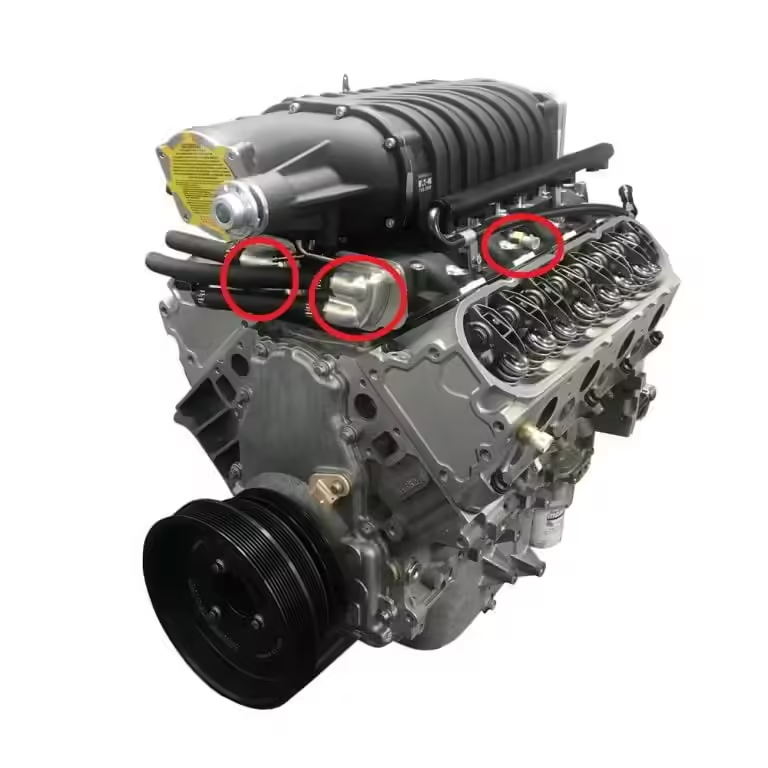
Upwards Discharge Superchargers Vs Downwards Discharge Positive Displacement Superchargers
The topic of upwards discharge and downwards discharge style blowers comes up in our line of work all the time.
We often find ourselves having to explain to people what the difference is and now instead we can direct those people here to read this tech article.
This tech article is designed to do 2 things:
1. Help you understand how both styles are different
2. How you can help/reduce associated issues
What is an upwards discharge style supercharger?
As the name implies the air that is discharged from the rotor pack is discharged upwards, an example of this would be an LSA supercharger or a Magnuson Heartbeat (there are many other makes but that’s 2 common examples).
After the air exits the rotor pack we have 2 goals with the air, we want to cool the air off with an intercooler and we want to bend the air the least aggressive way possible between the rotor outlet and the intake port of the cylinder head. This is important because the more we bend the air the hotter the air gets and the slower the air speed. If we bend the air too aggressively it will slow in speed and it will get hotter.
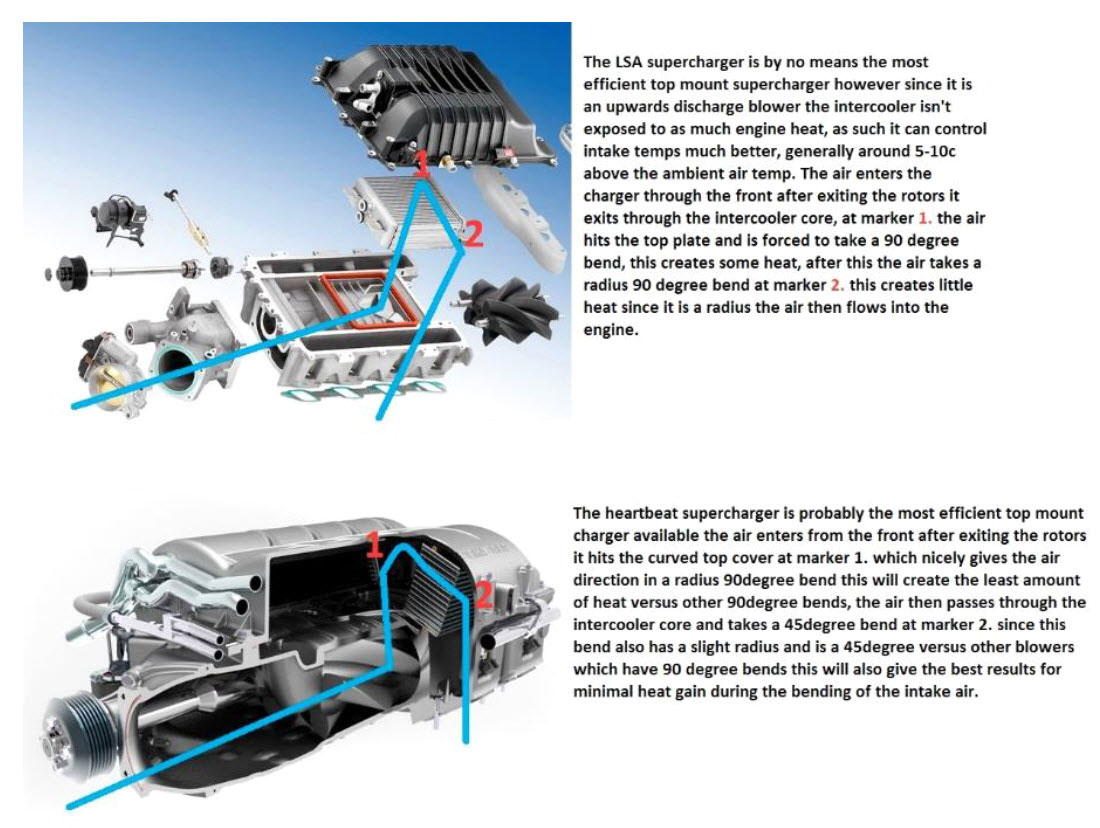
What is a downwards Discharge Style Blower?
As the name implies the air that is discharged from the rotor pack is discharged in a downwards direction, an example of this would be a Whipple Supercharger or a Harrop FDFI 2300/2650 (there are many other makes but that’s 2 common examples).
Just like the upwards discharge style blower we have 2 goals with the air, we want to cool the air off with an intercooler and we want to bend the air the least aggressive way possible between our rotor outlet and the intake port in the cylinder head. This is important because the more we bend the air the hotter the air gets and the slower the air speed. If we bend the air too aggressively it will slow in speed and it will get hotter.
Unfortunately downwards discharge style blowers cannot achieve the same level of efficiency in cooling or air flow as an upwards discharge style blower for reasons based around compact design constraints and location of the intercooler.
Problems:
We have several problems occurring in the downwards discharge blower;
1. The air generally is hitting a flat surface in the base of the blower casing after it exits the rotor pack this forces the air to take sharp 90 degree bends slowing the air speed and heating the air up.
2. Because this flat surface is very close to the engine heat source of 100c (212f) the surface is also extremely hot.
3. The next concern is that the intercooler is trapped in the belly of the blower, basically in or almost in metal to metal contact with the 100c (212f) engine as we all know heat rises and this causes a significant rise in the intercoolers ability to remove heat from the boosted air (more details on this below).
4. Lastly the final issue is the location of the IAT (intake air temperature sensor location) generally this too is getting heat soaked from the 100c (212f) engine heat and not reading true air temps (more on this later).
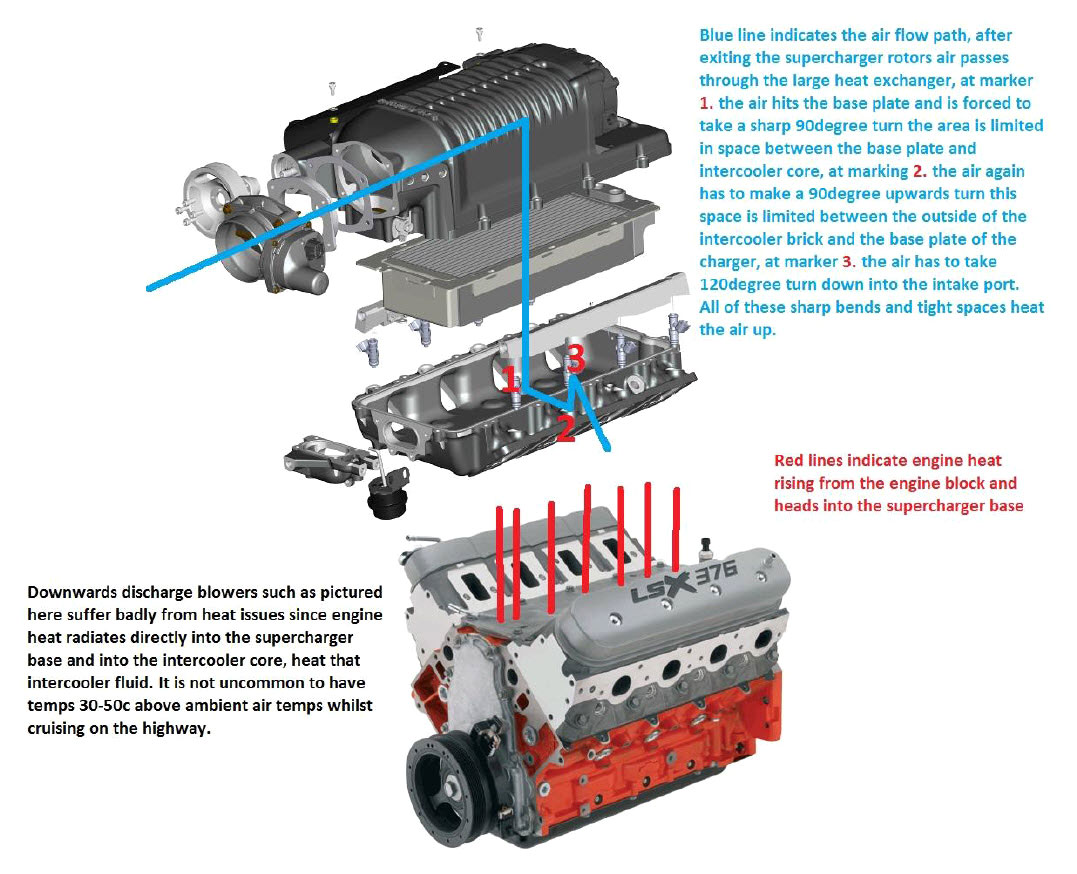 Solutions:
Solutions:
At this point you’re probably thinking “that’s it I’m selling my supercharger and getting a more efficient one”. Whilst this isn’t an option for everyone there are 2 ways we can improve (not fix) but improve your downwards discharge style blower.
1. Relativity inexpensive you can install one of our thermal reduction blankets, this radiates engine heat away to help reduce the amount of heat absorbed into the belly of the supercharger, more info can be found about how the blanket works and reduces heat soak here: https://fiinterchillers.com/thermal-reduction-blanket/

2. Next our goal is to get the blower up off the hot engine, isolating it as best as possible from the engine heat source and the cylinder head heat source, both around 100c (212f) we can achieve this with our blower spacer plates which raise the blower up about 12mm, more info can be found about how the plates function and reduce heat soak here: https://fiinterchillers.com/blower-spacer-plates/
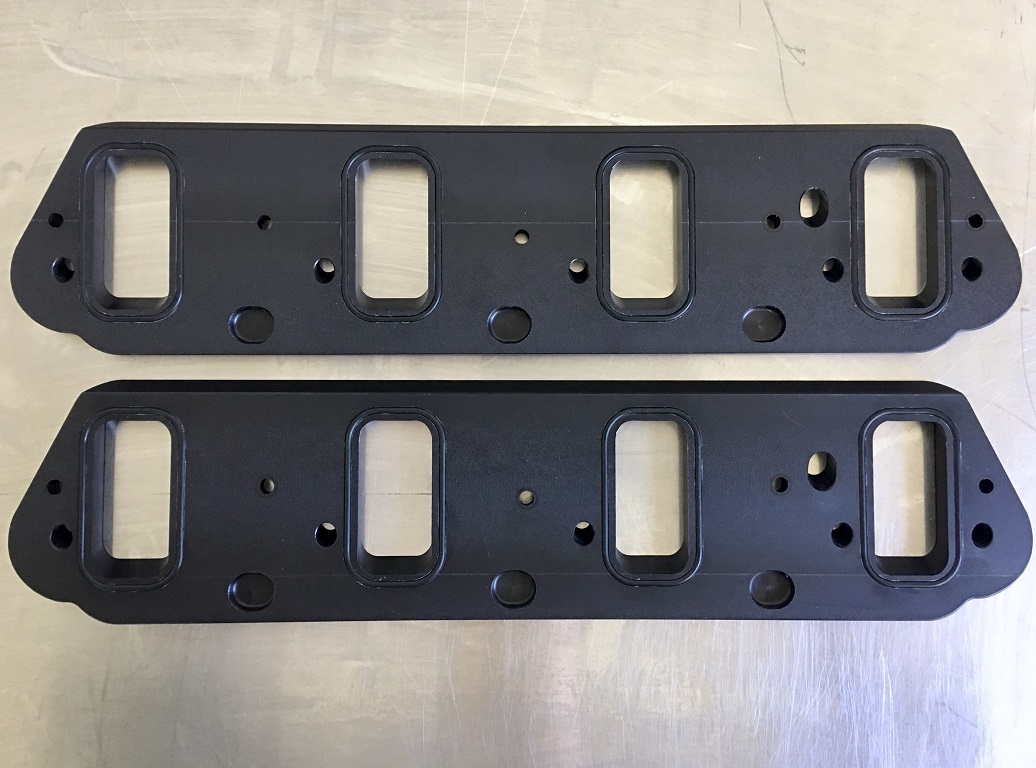
Now at this point you may very well be thinking “They are trying to make me buy not 1 but 2 products that they sell”. The answer to that assumption is 2 fold yes and no. Yes if you would like to help fix your blowers heat soak issues and no we are only trying to educate you so you can make better choices say if you were in the market looking to buy a supercharger or if you do actually want to help reduce some of your heat soak issues.
Lets get into some facts:
If you call or email today to place an order with us for an interchiller we discuss with you what type of supercharger you have, as example if you said you had a whipple or a harrop blower as mentioned above we will NOT sell you an interchiller unless blower spacer plates and a thermal blanket are also purchased at the same time, or you already have them installed. The reason being is our chiller is trying to get down to a certain temp it physically cannot get to that temp when fighting 100c (212f) engine heat and as a result of this the cabin AC doesn’t function, AC compressor cooling is also lost and eventual failure of the AC compressor occurs. We simply cannot fight that much heat load.
Yes some people have lied saying they have our blanket and plates when they don’t and then the phone calls start complaining that the chiller isn’t getting as cold as expected and that the cabin AC doesn’t blow cold. After finding out that the plates and blanket were not installed then when finally installed……MAGICALLY the problem is fixed!!! The chiller gets colder and the cabin AC functions properly, those miracle products we said you needed actually were needed.
Now if you call up and say you have an LSA or a heartbeat and you ask about the plates and blanket we advise the truth they are not as needed on your style of blower however they do still benefit in getting the blower isolated from the engine, the blower temp is lower and the intercooler temp also drops lower, in comparison here with an upwards discharge style blower we have made a good blower great and with a downwards discharge style blower we have made a bad blower better…not good….better. The downwards discharge blower simply can never perform as well as the upwards discharge style blower. We are reducing the problem the downwards discharge blower has but it’s not completely fixed, it’s far better than what it was.
This is also the reason why you see so many LSA’s and heartbeats getting so cold that the intercooler lines going into the blower form ice where as the other downwards discharge style blowers even with plates, blankets and our stage 2 chiller kits do not form ice, they are still getting very cold with the chiller…just not cold enough to form ice.
Lets have a BBQ!
The intercooler placement on these downwards discharge style blowers is almost as bad as saying lets run our intercooler on a BBQ…whoever thought that was a good idea?
Lets take a look here at the LS3 based Harrop 2650 FDFI supercharger, here in this image below you can see the blower is upside down on a workbench. Circled in RED we can see where the 2 intercoolers are located.

Now in this image below we can see with the blower installed on the engine that both intercoolers are basically in metal to metal contact with the engine, circled in RED, also circled in RED is the IAT2 (intake air temperature sensor) this sensor is right next to the cylinder head, this location doesn’t and cannot ever read true air temperatures because it is heat soaked (more on this shortly about IAT sensor placement).
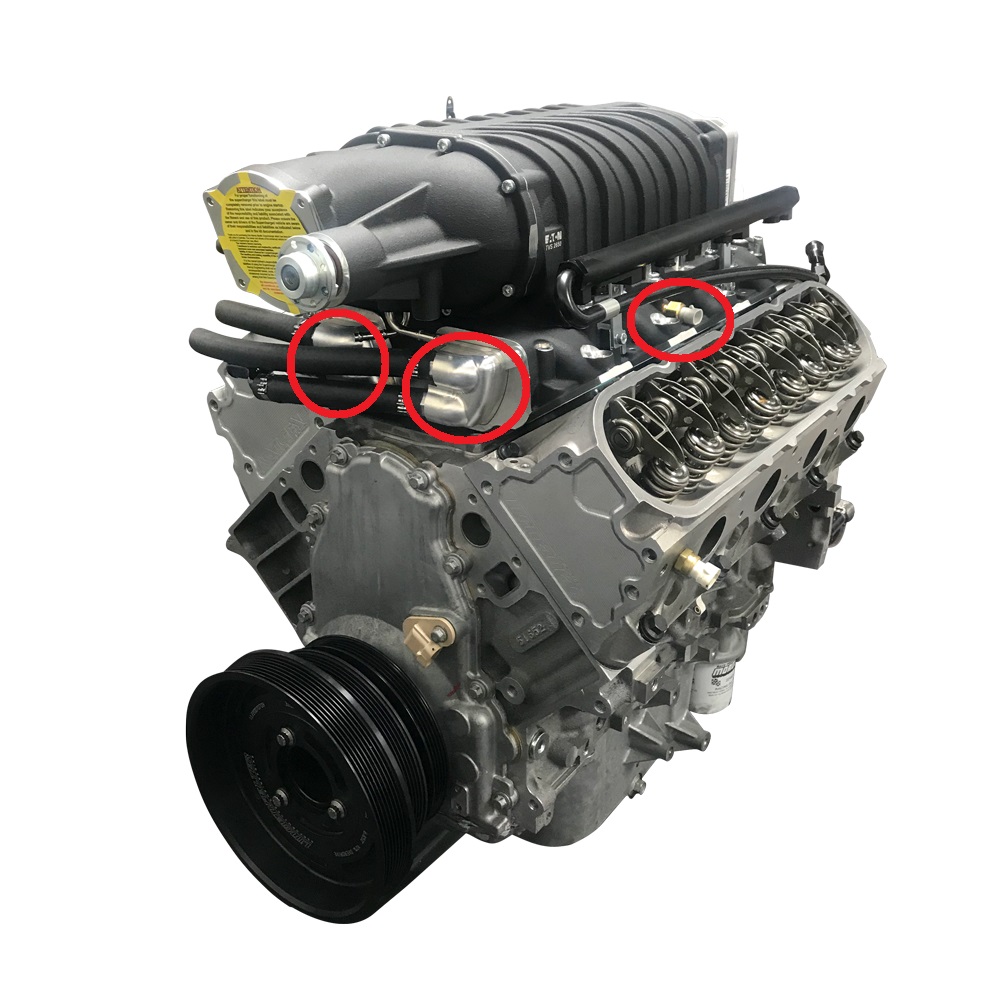
As you can see a viable solution to help reduce heat soak on both an upwards discharge and downwards discharge style blower is to use both blower spacer plates (getting the blower up off the hot engine whilst also rejecting some of the cylinder head heat from absorbing) and also installing our thermal blanket (rejecting some of the valley plate heat from absorbing into the blower base).
We have had customer/workshop reviews using just our plates and blanket on downwards discharge style blowers showing 20-25c (36-45f) reduction in intake termps, here are a couple.
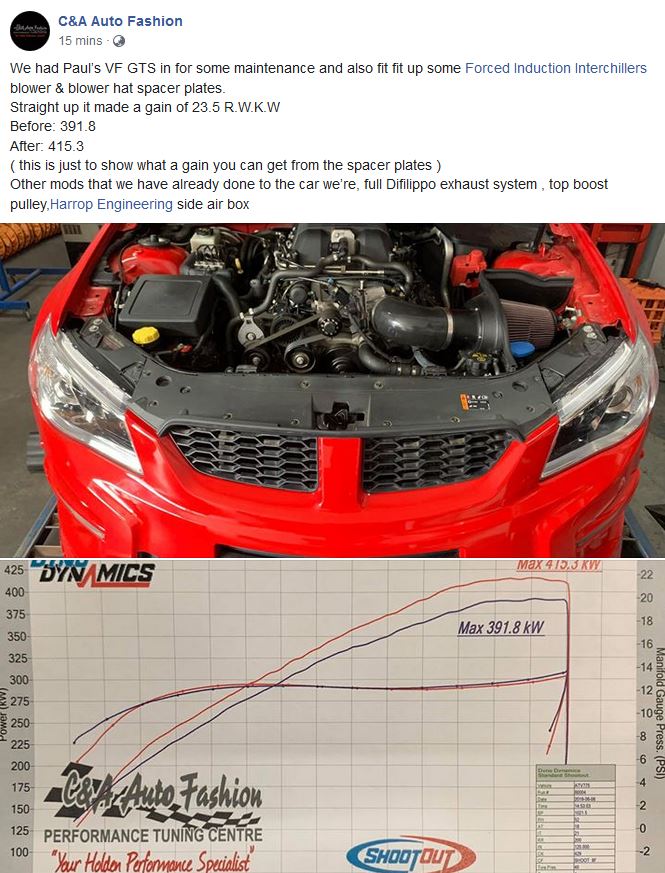

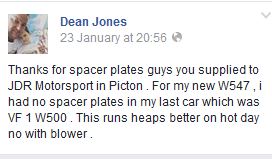
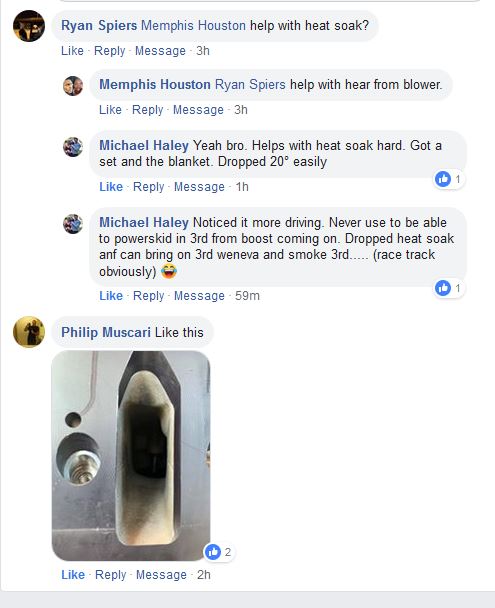

(Intake Air Temperature) Sensor Placement:
Since we’ve got a lot of customers all over the world with all different types of superchargers it’s is very easy and quick to diagnose if an intake air temperature sensor is incorrectly/badly placed.
We are going to give a few examples here so we can keep the information relative.
LSA Supercharger:
There is no denying this blower is very efficient, with a chiller we’ve seen some crazy cold intake temps, however in this example we are going to use it as our baseline data point, we know there is a 7-10c (12.6-18f) difference between the intercooler fluid temperature and the IAT2, lets round this off to the higher number of 10c (50f) for simplicity sake. So the example is if our fluid temp is 0c (32f) our IAT2 will be 10c (50f).
Magnuson Heartbeat Supercharger:
Also no denying this blower is extremely efficient, even more efficient than the LSA, however whilst this isn’t an issue what we are about to point out is relative to the following examples below. We have found that once at operational temperature there is a 15c (27f) difference between the intercooler fluid temp and the IAT2. This is actually very interesting and was easy to diagnose too.
What happened was during the first 15-20min of engine operation from a cold start there was a 10c (18f) differential between the intercooler fluid and the intake air temp, after 20min this changed to 15c (27f). The reason this occurred was simple, because the rotor pack discharges it’s heat directly into the supercharger lid with no intercooler between the rotor outlet and lid the rotor pack heat was able to heat soak the lid of the charger, that heat then worked it’s way down the lid and heat soaked the IAT sensor…this IAT sensor is reading incorrectly by 5c (9f) when a room temperature wet rag is placed on the IAT sensor it takes away the heat soak (proving the sensor was heat soaked) and the temperature differential is back to a 10c (18f) difference between fluid temp and IAT2.
To be clear this isn’t an issue, the intake air temps still have a very large swing in temperature which enables the tuner to tune ignition timing vs temperature extremely well…just that the temps are out by 5c (9f)…which isn’t much.
LS9 Supercharger found on the Corvette ZR1 and HSV W1:
This one is very interesting back in 2017 when we were in the USA we fitted a chiller to a car fitted with an LS9 supercharger, initially once the install was complete and the AC recharged our fluid temps were 0c (32f) and IAT2 was 10c (50f), after 30-45min fluid temp was 0c (32f) but IAT2 had risen to 51c (125f). After thinking the sensor had failed and swapping to other ones we found the issue. It was the actual design of the lid on the blower and the material type. We then swapped to an LSA lid with an adapter plate and the fluid temp was 0c (32f) and IAT2 held at 10c (50f) and did not change at all. Based on the design of the LS9 blower we would never have thought that would have been an issue but clearly it was, the supercharger housing was transferring its energy into the lid of the blower and the sensor was so hot we could only hold it for 2-3 seconds or risk burning our fingers. (supercharger housing is in bold for a reason for below examples).
Harrop 2300/2650 FDFI:
With the Harrop LS3 based blowers we have found flaws in the IAT2 sensor placement, it’s location as circled in the above picture is in the 2nd runner this is located right next to the cylinder head, in the supercharger housing so not only is the sensor absorbing engine heat it’s also absorbing blower case temperature and cylinder head temperature (3 heat source locations) we have found that we can have 10c (50f) fluid temps and that the IAT2 can be as high as 35-40c (95-104f). This poses a tuning issue, we need accurate temperatures or near enough accurate and we need them to swing in temperature when you go wide open throttle as example if the temp is 40c (104f) we need that temp to climb up to at least 70c (158f) for a window to tune ignition timing vs temperature. Luckily with blower spacer plates fitted and a thermal blanket this window for tuning does exist. However without blower spacers plates and thermal blanket no such window exists you could have 0c (32f) or 40c (104f) fluid temps and the IAT2 would be the same because the sensor itself is so heat soaked.
Remember back above to the LS9 example, that sensor was in the lid absorbing blower case temperatures, the sensor in the harrop blower is in the actual case, in the actual runner, right next to the cylinder head. In this particular case without blower spacer plates and a thermal blanket you have ZERO ability to tune for temperature. We were baffled when this blower was released and Harrop claimed their IAT only climbed by 10c (18f) on a dyno power run and that this was the best most efficient blower they had produced….it only climbed by 10c because the sensor was so heat soaked, once we installed a chiller again we see all of the flaws of that blowers design.
Whipple 2.9L, 4L, 4.5L:
The whipple’s IAT sensor placement and intercooler placement whilst not ideal is better than the above mentioned Harrop blower.
What we see on the whipple is that the IAT sensor is located at the rear of the blower and it is not in the direct air flow path, whilst it is close it’s not directly in the air flow path we can have a 0c (32f) fluid temp and a 32c (89.6f) IAT2 however the intercooler in the whipple by the design engineers has been risen up off the base of the blower by just enough room to allow it to not absorb as much engine temperature as the harrop blower in this case we often see with a chiller fitted you can have a 32c (89.6f) IAT2 but when you go wide open throttle the IAT2 actually drops down as low as 15c (59f) then it starts to climb in temperature. This is happening because the sensor is being cooled off by the cold boosted air now hitting the IAT2 sensor, whilst these temperatures are likely a little higher than the actual air temp a window for tuning exists and is far more predictable.
C63 Weistec Supercharger:
This example is really good a special thanks to Autowerks Automotive on this one, their customer wanted accurate data for intake air temps as the car was a drag car they decided to fit 2 additional IAT sensors to the blower. This blower is downwards discharge in nature with the intercooler similarly placed to the whipple in that it’s in the base of the blower but has a small gap between it and the blower base. The factory IAT sensor was in the rear of the blower just like the whipple blower, a 2nd sensor was added into the #2 runner near the head just like the harrop blower (absorbing cylinder head temps, blower case temperature, engine temperature) and a 3rd sensor was fitted directly under the blower in the middle of the rotor pack discharge under the intercooler, the sensor was then heat shielded with our thermal blanket to protect it from absorbing engine temperature. Of the 3 sensors the one placed in the runner read the hottest and didn’t have a large tuning window the one at the rear was okay but still not true air temps but did have a better tuning window and the one under the blower was the coldest (it was assumed the air temps were not 100% accurate on the sensor under the blower due to some heat soak) however the sensor had a good swing in temperature (tuning window) and gave the best ability to tune for both hot and cold intake temps.
Now we understand there are many fan boys of certain brands of blowers out there who have these blowers and this information is either going to upset you, make you angry, however what is posted here is factual, so don’t blame the messenger we’ve simply told you what we’ve experienced and the feedback we have received from workshops.
Something you should keep in mind if you question why your mechanic pushed you to a certain brand of blower over other options and why their opinion on this maybe COMPLETELY different to the facts posted here. The profit margins from trade to retail on some brands are very good in comparison to other brands.
We’ve even heard customers tell us that their tuner said to buy brand X over brand Y because it drives better….there is psychically nothing different that would make one blower “drive” better than the other, one may perform better making more HP but in terms of drive ability this is not impacted between the 2 brands…what is different is the profit margin….FYI we have no financial interest in either any of the mentioned brands of blowers.
What is posted here is only the facts and our advice to use blower spacers and a thermal blanket to help reduce the issues associated to downwards discharge style blower design flaws and allow you to drop intake temps and gain a larger tuning scope for ignition timing vs temperature with and without a chiller. To be very clear there are issues here but we can reduce these issues with the spacer plates, blanket and ultimately the interchiller.
Summary:
These examples prove how critical it is for having accurate data for intake air temps or at least having data which has a decent tuning window which enables the tuner to tune for both hot and cold intake temps, it also shows the importance of using blower spacers and a thermal blanket should you have a downwards discharge style blower and how they can also be useful on an upwards discharge stye blower like we said before we can make an upwards discharge blower go from good to great and a downwards discharge go from bad to better.
You’d hate to think on a cold day or with a chiller your car is making the same power as it does on a hot day or without a chiller simply because your IAT sensor location is letting you down from heat soak or your intercooler is absorbing 100c (212f) engine heat.
